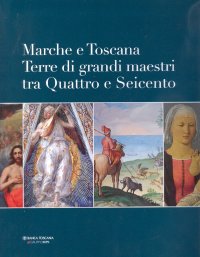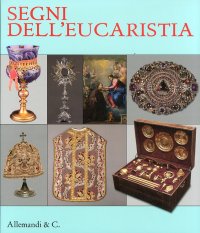Beato Angelico
Firenze, Palazzo Strozzi, September 26, 2025 - January 25, 2026.
Edited by Carl Brandon Strehlke.
Testi di Stefano Casciu, Marco Mozzo, Angelo Tartuferi.
Venezia, 2025; bound, pp. 456, 300 col. ill., cm 24x29.
cover price: € 80.00
|
Books included in the offer:
Beato Angelico
Firenze, Palazzo Strozzi, September 26, 2025 - January 25, 2026.
Edited by Carl Brandon Strehlke.
Testi di Stefano Casciu, Marco Mozzo, Angelo Tartuferi.
Venezia, 2025; bound, pp. 456, 300 col. ill., cm 24x29.
FREE (cover price: € 80.00)
Marche e Toscana. Terre di grandi maestri tra Quattro e Seicento
Ospedaletto, 2007; bound, pp. 320, col. ill., col. plates, cm 25,5x29.
FREE (cover price: € 77.00)
Segni dell'Eucarestia
Edited by M. Luisa Polichetti.
Ancona, Osimo, Loreto Jesi, Senigallia, Fabriano e Metelica, 23 giugno - 31 ottobre 2011.
Torino, 2011; paperback, pp. 221, b/w and col. ill., cm 24x28.
FREE (cover price: € 32.00)
Il Palazzo della Consulta e l'architettura romana di Ferdinando Fuga
Francesco Nevola - Palmer Lancey Vanessa
Ugo Bozzi Editore s.r.l.- Edizioni per la Storia dell'Arte
Edited by Soprintendenza beni architett. e artistici di Roma.
Roma, 2004; bound, pp. 600, 263 numbered b/w and col. ill., 46 b/w plates, cm 25,5x29.
(Collana Classica).
series: Collana Classica
ISBN: 88-7003-037-7 - EAN13: 9788870030372
Subject: Architects and their Practices,Civil Architecture/Art,Restoration and Preservation
Period: 1400-1800 (XV-XVIII) Renaissance
Places: Rome
Languages: 
Weight: 3.98 kg
The Palazzo della Consulta, commissioned in 1731 and completed by 1737, was built to accommodate the secretariates of two important offices of papal government, the Congregazione della Sacra Consulta and the Segreteria dei Brevi, as well as the quarters of two papal bodyguard corps, the Cavelleggeri and the Corazze. Paid for entirely by the proceeds of the newly-reinstated lottery, the Palazzo della Consulta was one of the most significant commissions of Clement XII's pontificate during which an extensive programme of building works was initiated, the scope and the intentions of which will be investigated. The Consulta also represents the most important commission of the early career of Ferdinando Fuga, who like his papal patron was a Florentine. Fuga's employment in 1730 as one of the two Architects of the Apostolic Palaces represented a turning point in his career and his work at the Consulta established him as one of the preeminent architects working in Rome. The Palazzo della Consulta was his first entirely ex novo building, providing him with an unprecedented opportunity to demonstrate his skill in planning and distribution and to further formulate his architectural language. The Palazzo della Consulta is characterised by its multifunctionality, reflected in its use of two very different architectural styles, and its intensive use of space on an awkward site. With the aid of archival documents, autograph drawings and contemporary and later prints and descriptions, this study provides a detailed architectural history of the palace that is complemented by new photographs of the building, while an account of the fascinating history of this site, once occupied by the Baths of Constantine, locates the palace in its historical and urban context.
The book also explores the most important of the interior decorations at the Palazzo della Consulta which are concentrated in the apartments of the Cardinal Segretario dei Brevi and which have recently undergone restoration. These apartments are marked by three distinct stages of decorations, each reflecting the interests of the commissioning sovereign. Between 1737 and 1744 the ceiling vaults were decorated by Antonio Bicchierari, initially at the behest of Pope Clement XII. Bicchierari's decorations celebrate the pope's individual qualities as exemplary and focus on the ideal of virtue that the Church aspired to embody and promote, while referring also to the economic concerns of the pontificate. The second decorative intervention (1787-1790) was executed in the innovative neo-classical style by Bernardino Nocchi for Pope Pius VI Braschi. The complex iconography employs mythological and allegorical subjects to portray the pope as an enlightened ruler, celebrating the creation of the Museo Pio-Clementino and alluding also to his agricultural and economic initiatives. Additionally, the Christian belief in life after death is examined through the filter of antique sources, and the themes of virtue introduced earlier in the century are elaborated further. The final phase of decoration, executed between 1870 and 1874, reflects the taste of Italy's new monarchy. Prince Umberto I and his consort Margherita of Savoy commissioned the painters Cecrope Barilli, Domenico Bruschi and Annibale Brugnoli to produce decorative floral works and a narrative celebrating industrial progress. This intervention saw the destruction of much of the earlier works, however, these are reconstructed in this study with the aid of drawings and documentary evidence.
By means of an exploration of the architecture and decoration of the Palazzo della Consulta, of its urban location and of the artistic policy of the patrons who at different periods financed works at the palace, a more complete picture will emerge not only of the building, but also of changes that took place within the Roman art scene between the eighteenth and nineteenth centuries.











